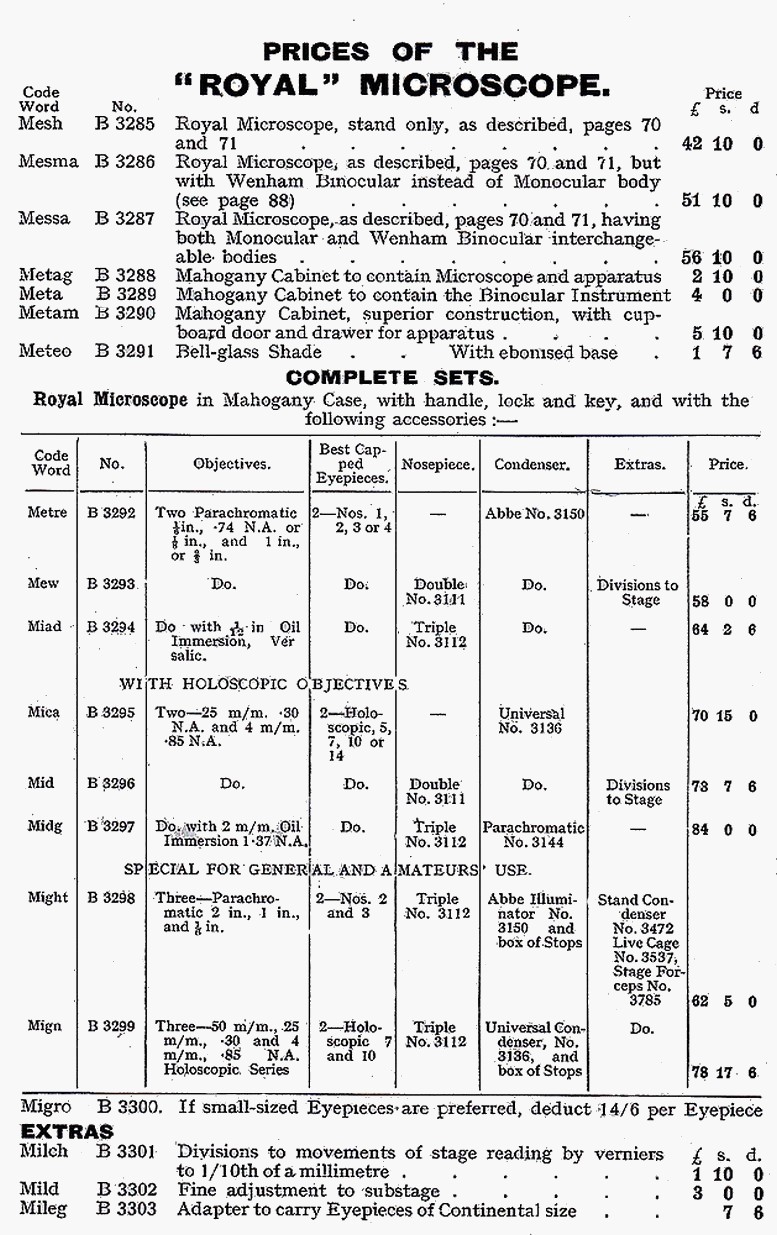






Among the accessories are four objectives with canisters (one not shown in this image),
three eyepieces, a sub-stage Abbe condenser with iris and centering adjustments, and
a brass canister containing a selection of stops for use with the condenser.


The following was taken from the 1925 Watson Catalog:

THE “ROYAL” MICROSCOPE.
Carries larged-sized Eyepieces: has Mechanical and Sliding Draw-tubes:
stage bolted to limb as in Van Heurck Microscope: new swinging-out Substage.
For-high-class practical work, with absolute rigidity, in a convenient size,
this Instrument is unexcelled, for it combines all those working qualities
which have gained so high a reputation for thé Van Heurck Microscope, but
in a more compact form and at a lower cost. The height, when placed vertical
and racked down, is 11¾ inches. The tripod foot is shod with cork and
has a spread of 7 inches.
The Mechanical Stage is our Standard pattern. It has a horizontal movement of
1½ inches, and is covered with ebonite attached by a vulcanizing process.
It is fitted with a sliding bar.
The Mechanical Draw-tube with inner sliding draw-tube, as described page 75
is incorporated. It carries eyepieces 1.27 in. diameter, but, if so desired, can
be supplied to carry eyepieces of the Students’ or Continental size.
The Union or Parts The method of uniting the stage and limb and bolting
all together, as described with the Van Heurck Microscope, on page 76 is used
here. Further, the limb is continued beneath the stage and carries the Compound
substage. The latter is therefore quite independent of the stage itself. This
will be more clearly understood by reference to the accompanying illustration.
It will be observed that the Stage base is continued in a solid casting so as
to embrace the Limb “A” to which it is screwed, the axis bolt passing through
the hole at “B” The Limb “A” is continued downwards so as to support the stage
base from beneath and carry the Substage on the part marked Al.

The Substage, which in the regular model has course adjustment
and centering screws only, but may be provided with fine adjustment if desired at
an extra cost, has, in addition, a new swing-out arrangement for turning
the condenser and the centering fitting only, out of the optical axis, as shown
in the illustration, “C” representing the axial position and “D" when turned
aside. A spring catch secures all when the condenser is in use. E and F represent
the milled heads of-the fine and coarse adjustments of the Substage respectively.
The Fine Adjustment is our standard lever pattern.
It will thus be seen that the many special features combined in this Microscope
render it suitable for those who require an instrument of the highest class.
It will be found to respond in the fullest manner to the exacting demands of
the photo-micrographer and high-power worker. Its many conveniences enable
the best results to be obtained rapidly with all types of objectives. It is
invaluable in the laboratory, for which its strong construction and excellent
mechanical stage are especially advantageous, while for the varied purposes
of the Amateur it is unequalled.
